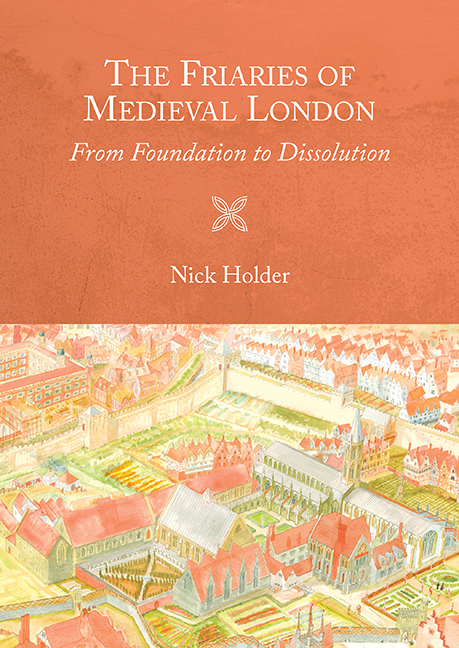Book contents
- Frontmatter
- Contents
- List of Illustrations and Tables
- Contributors
- Acknowledgements
- Abbreviations
- Introduction
- Part I The Nine London Friaries
- 1 The First Black Friars in Holborn, c. 1223–86
- 2 The Second Black Friars, 1275–1538
- 3 The Third Black Friars at St Bartholomew's, 1556–9
- 4 Grey Friars, 1225–1538
- 5 White Friars, c. 1247–1538
- 6 Austin Friars, c. 1265–1538
- 7 Crossed Friars, c. 1268–1538
- 8 Sack Friars, c. 1270–1305
- 9 Pied Friars, 1267–1317
- Part II The London Friars and their Friaries
- Conclusions
- Timeline
- Bibliography
- Index
- Miscellaneous Endmatter
3 - The Third Black Friars at St Bartholomew's, 1556–9
from Part I - The Nine London Friaries
Published online by Cambridge University Press: 16 May 2018
- Frontmatter
- Contents
- List of Illustrations and Tables
- Contributors
- Acknowledgements
- Abbreviations
- Introduction
- Part I The Nine London Friaries
- 1 The First Black Friars in Holborn, c. 1223–86
- 2 The Second Black Friars, 1275–1538
- 3 The Third Black Friars at St Bartholomew's, 1556–9
- 4 Grey Friars, 1225–1538
- 5 White Friars, c. 1247–1538
- 6 Austin Friars, c. 1265–1538
- 7 Crossed Friars, c. 1268–1538
- 8 Sack Friars, c. 1270–1305
- 9 Pied Friars, 1267–1317
- Part II The London Friars and their Friaries
- Conclusions
- Timeline
- Bibliography
- Index
- Miscellaneous Endmatter
Summary
IN August 1553 England's experiment with religious reform and the country's uneasy shift to Protestantism came to an end with the entry of Queen Mary into London. It would only be a matter of time, surely, before the largely unwelcomed changes of the previous two decades – the break with Rome, the stripping of church decoration, the introduction of the vernacular common prayer book and the Dissolution of the Monasteries – would all be undone. The efforts of Mary, her husband Philip of Spain, the Privy Council and the new archbishop of Canterbury Reginald Pole successfully reversed some of those Protestant reforms in 1553 and 1554, bringing back traditional worship in churches and reuniting the English church with Rome. However, the Dissolution of the Monasteries could not be undone quite so quickly: too many powerful people – including many traditional Catholics – had paid good money for ex-monastic property and were not about to hand it back to the various monastic orders, although this was what Mary and Pole had originally intended. Mary and Pole therefore began the slow process of refounding monastic houses, beginning in London and the south-east of England. In 1555 they were able to endow and renew the house of Observant Franciscans at Greenwich and that of the London Carthusians, now moved to Sheen. The next year saw the re-establishment of the Black Friars at St Bartholomew's (the subject of this chapter) and the return of Benedictines to Westminster, followed by, in 1557, Dominican nuns returning to Dartford (initially to Kings Langley) and the Bridgettines to Syon. There was some discussion about the re-establishment of the London Grey Friars – in their old home – but it was not thought possible or desirable to close down the newly founded school and orphanage of Christ's Hospital, which had opened in 1552 in the old friary. The London Dominicans were, therefore, a significant part of a remarkably small group of religious men and women who returned to their vocation when the opportunity arose in Mary's reign, a very brief opportunity as it turned out.
The Dominican friars refounded their London house in 1556, not at their old cloister at the eponymous Blackfriars but 500 yards to the north-east in the former Augustinian canons’ house at St Bartholomew's.
- Type
- Chapter
- Information
- The Friaries of Medieval LondonFrom Foundation to Dissolution, pp. 57 - 65Publisher: Boydell & BrewerPrint publication year: 2017



